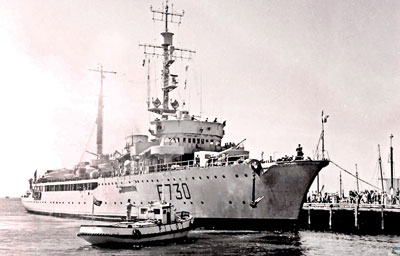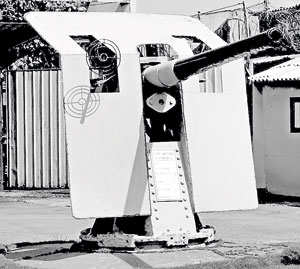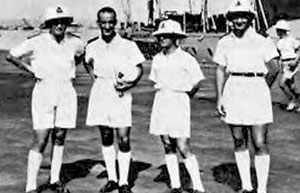Ceylon Navy’s prized ‘catch’

Italian Navy ship “Eritrea”
“Do you know how an Italian Navy ship surrendered to the CRNVR?”
It was around the middle 1970s. I was collecting first-hand accounts of incidents involving the Ceylon Naval Volunteer Force (CNVF) which had been mobilized by the Royal Navy as the “Ceylon RNVR”(CRNVR) during the second world war. The question was put to me by Cdr. E.P. Wickremasinghe (SLN), a veteran of that war.
“Surprised?” he went on, “but it happened. I was there!”
HMS Overdale Wyke, FY 338, of the CNVF/CRNVR was on patrol off Colombo. It was September 1943.
“OW” was the first ship purchased by the government of Ceylon for the CNVF; 136 ft. in length overall and displacing 764 tons under load, she was a trawler fitted out as a minesweeper. The sea was calm and her (coal-fired triple-expansion steam reciprocating) engines were turning her single screw over at comfortable cruising speed. Still, extra look-outs had been posted because of a message received: Italy had surrendered on September 8 and Italian naval units all over the world had been ordered to surrender to the nearest Allied unit.
“OW” was to keep a sharp lookout for Italian ships and submarines which may appear. Signalman Wickremasinghe was on duty on the bridge as yeoman to the Captain, Lt. Cdr AHH Boyns, a Mackwoods employee before mobilization.
Suddenly, a look-out spotted a large vessel on the horizon, apparently making for Colombo. Altering course, Lt.Cdr. Boyns set out to intercept her. The other ship, too, changed course and headed towards “OW”. As the distance between the two ships diminished it became alarmingly obvious that the newcomer was very much larger than “OW”, leading to much trepidation!
But duty had to be done. Being in home waters, flying the White Ensign of the RN,”OW” challenged the unknown ship to identify herself and state her intentions. Pat came the reply:
”Royal Italian Navy Ship ‘Eritrea’ surrendering to you!”
Lt. Cdr. Boyns had rehearsed the drill. Acknowledging the signal, he instructed Eritrea to stop engines, fly the white flag of surrender, muster all hands on deck and prepare to be boarded. A prize crew from the CNVF vessel then boarded the ship, accepted the surrender, assumed command and Overdale Wyke proudly escorted Eritrea to Colombo.
A significant moment for the CNVF, but totally unrecorded anywhere – save in the memory of one sailor. I used his story, of course, attributing it to him, but I failed to find any corroboration by a third party. Even the internet did not help me till when, very recently, trawling the net yet again I chanced upon a site http://military.wikia.com/wiki/Italian_sloop_Eritrea which finally gave me the clue:
“As soon as the Reuters message about the surrender of Italy was picked up by the crew of Eritrea, the vessel changed course at once and headed at full speed to Colombo in Ceylon to surrender when it was intercepted and escorted to Colombo by units of the Ceylon Naval Volunteer Force”.
And with that, it became possible to recreate the circumstances under which this historic event took place – the one and only time the Ceylon Navy secured a ‘prize’. It is an event worth memorializing.
‘Eritrea’ in the the Red Sea
The commencement of the Second World War, in Europe, is formally dated from 1939, but the Axis (Germany and Italy) and Allied Powers (led by Britain) had been preparing for a possible war for some years. Italy’s Regia Marina (“Royal Navy”) was a respectable naval force in the Mediterranean: Ethiopia and Eritrea in East Africa, on the southern end of the Red Sea were under Italian control. This gave Italy access to the Red Sea and a formidable port had been built up at Massawa. It was here that Eritrea was based. Displacing 2,170 tons she was constructed as a typical “colonial ship” and fitted with diesel-electric propulsion designed to maximize range. She was sometimes referred to as a “sloop.” [“In modern usage, a sloop refers to a warship between a corvette and a frigate in size”].
With Italy officially entering the war in June, 1940, Eritrea was absorbed into the Regia Marina as part of the Red Sea Flotilla based at Massawa on the Red Sea. Initially the East African Campaign went in Italy’s favour and, with the capture of British Somaliland soon after, Italy gained access to the former British port of Berbera, on the horn of Africa, and posed a threat to Allied shipping in the Red Sea. But this was a short-lived phase as the British counter-attacked a few months later and put an end to the Italian presence in East Africa. The Red Sea Flotilla was largely destroyed: largely, but not quite. Four submarines sailed south, rounded Africa and made it to German-occupied France while two surface ships made it to Vichy French controlled Madagascar.
Eritrea decided on another destination. The Regia Marina had a naval base in the concession territory of Tiensin in China. During World War II, Italian supply ships, auxiliary cruisers and submarines operated in the Far East, often in disguise, even utilizing Japanese-controlled port facilities such as those at Shanghai, China, and Kobe, Japan. Eritrea and two ‘auxiliary cruisers’ (newly-built, converted cargo ships) Ramb I and Ramb II slipped through a British blockade, opting to make a run for Kobe and to carry on the fight in another theatre of war. Eritrea and Ramb 2 successfully reached Kobe, but Ramb I was not so lucky, having been intercepted and sunk off the Maldives by the New Zealand cruiser HMZS Leander.
HMS ‘Overdale Wyke’
Coincidentally, Overdale Wyke was also in the vicinity of the Red Sea about this time. Built as a Trawler in 1924, she had been commissioned into RN service as a Minesweeping Trawler in 1937 and sold to the Government of Ceylon, fitted out with minesweeping gear and armament, and sailed to Port Said by a RN runner crew to await a Ceylonese crew there. The CNVF/CRNVR crew including Lt. P.J.B. Oakley (C.O.), Lt. A.H.H. Boyns, Lt. B.A. Ohlson, Lt. A. Smith (Engineer), P/O Stanislaus, P/O (Tel) Rankine, P/O (SM) Bastiampillai, P/O (CK) Marshall and Stwd. Eric Perera left Ceylon by ship on 20th February (as Eritrea was sailing out of Massawa) reaching Port Said 3rd.March. CRNVR records show the date of commissioning as a CNVF vessel as 15th March, 1941. Eritrea had sailed away from the Red Sea on 20th February, just two weeks earlier.
From March 1941 to December 1944 “OW”, with a complement of 4 officers and 40 sailors, was continuously used for a variety of duties involving patrolling, minesweeping, providing escort services, search-and-rescue work and anti-submarine attacks which have been recorded. Along with other CNVF ships Hoxa,Balta (also trawlers but larger than her) Okapi, Semla and Sambur (all converted Antarctic whalers) and supported by tugs Samson, Goliath and C-405 she was part of the Ceylon Escort Group, later designated the ABCD (“Arabia-Bangala-Ceylon-Dutch East Indies”) group, carrying out patrol, escort, search-and-rescue, guard-ship and sundry other duties off Ceylon, Bay of Bengal and as far west as Addu Atoll and Diego Garcia. She also served as Guard ship at Addu Atoll, a secret RN port called “Port T”. She is credited with the rescue of several persons from sunken ships, and of carrying out depth charge attacks on enemy submarines, although she has not been credited with any “kills”.
She seems to have been a happy ship: Lt.Cdr.BA Ohlson has commented that “The Overdale Wykeat all times proved a very satisfactory vessel for such operations, in which regard this vessel may be considered superior to any other vessel which the Ceylon RNVR has manned.” Lt.D.G. Simpson has concurred:”This has always been a grand ship with which to be associated and one in which there was plenty of scope for seamanship.”

12-pounder gun from the ‘OW’ which still stands at the entrance to SLNS Rangalle in the Port of Colombo
‘Eritrea’ in the Far East
Eritrea completed the hazardous Indian Ocean crossing and ultimately reached Kobe, Japan. She had planned to operate as a commerce raider in the Pacific Ocean. But, even though allied with Italy, the authorities of then neutral Japan took a dim view of the idea of an Italian raider operating from neutral Japanese ports. The Japanese refused to comply with the Italian plans and, because of the strong opposition presented by the Japanese Navy, Eritrea was not allowed to leave Kobe and both the Ramb II and the Eritrea were confined to port to avoid any confrontation with the USA and Great Britain. But December 7th, 1941, the day of the attack on Pearl Harbor, marked a change in policy. After the official declaration of war the Japanese government allowed Eritrea freedom of movement and to specifically provide assistance to the cross-oceanic transport submarines, which were arriving in Penang and Singapore from Bordeaux, in occupied France, carrying rare goods.
Some Italian Merchant Marine ships succeeded in transporting to Europe such hard-to-come-by goods, such as rubber, tin, and quinine. The Italian Navy, like the German navy, attempted to use submarines for transport of goods to Japan despite the high losses and small advantages. Seven Italian submarines operating from France were converted by the Italians into “transport submarines” in order to exchange rare or irreplaceable trade goods with Japan. They were converted for service with the Monsun Gruppe (“Monsoon Group”). Servicing and providing these with escort became Eritrea’s major activity till 1943.
The surrender
On September 8th, 1943 at 2:00 AM (local time), Eritrea was transferring from Singapore to Sabang in support of the submarine Comandante Cappellini which had just arrived after a long and difficult journey transporting strategically important material to Tokyo. Having received a Reuter communiqué of the Italian surrender, submarine Cappellini decided to disregard the call to surrender to the Allies and to fight along the Germans and the Japanese. But, once escorted to Singapore, the Japanese treated her as an enemy ship. Despite the pledge of allegiance of the Captain, Commander Auconi, Admiral Hiroaka interned the ship and imprisoned the crew. Eritrea, on the other hand, had no illusions about Japanese reactions to the surrender. Upon receiving the communiqué she realized her hazardous position and immediately changed course for Colombo (Ceylon) through the strait of Sumatra avoiding the tenacious hunt by Japanese naval and aerial forces that was bound to commence. And so was enacted the drama of the surrender off Colombo.
‘Eritrea’ repays a debt
On arrival at Colombo, “OW” handed over her prize to the RN authorities and, presumably resumed her work. The Italian surrender resulted from a revolt against Benito Mussolini who was deposed, although he had a hold over northern Italy. The new Government signed an Armistice with the Allies in terms of which the Regia Marina had to sail its ships to Allied ports. Those which eventually did were grouped into the “Italian Co-Belligerent Navy” fight on the side of the Allies. Eritrea fell into this category and was absorbed into the East Indies Fleet assembled to carry the war into Japanese controlled Burma. In a list of “British, Commonwealth and Allied warships serving in the Far East January to August 1945” she is shown as a “submarine escort (sloop)” attached to the 2nd Flotilla, Submarines.
During this time she had a bitter-sweet re-union with “OW”.Let Wickremesinghe narrate the story.

Eritrea, with Capt. Seculin, Simeoni, Lt. Gian Formaggio and Capt. Zampini
“Eritrea” was later used by RN in Colombo and Addu Attol. “OW”, on an escort mission to Diego Garcia, developed engine trouble S W of Colombo and drifted for 4 days. Food and water ran out, and there was no defence against any submarines. On the morning of 5th day, a warship was sighted heading directly on the “OW”. Anxious moments later she was identified as the “Eritrea” which had picked up her signal and was coming to her rescue.
In her own way Eritrea was repaying “OW” for saving her from the Japanese!
When the guns fell silent
After the war, Eritrea was turned over to France. The French Navy used Eritrea in colonial service with the name Francis Garnier until 1965. Francis Garnier was then declassed to become a target ship. She was sunk during a nuclear test in the Pacific Ocean in 1966.
And the OW” ? The CNVF was returned to the Ceylon Government by the RN and demobilization was commenced. The Government had no funds to run ships, nor was there any reason for any. “OW” was de-commissioned on 15th December 1944 and handed over to the Port Commission for care and maintenance pending final disposal by Government. On 16 March 1946 she was sold off, unsung and forgotten. Not even a photograph of her can be found.
Except for her 12-pounder gun which still stands at the entrance to SLNS Rangalla, in the Port of Colombo: the gun she would have had to depend on should Eritrea have decided to fight on!


